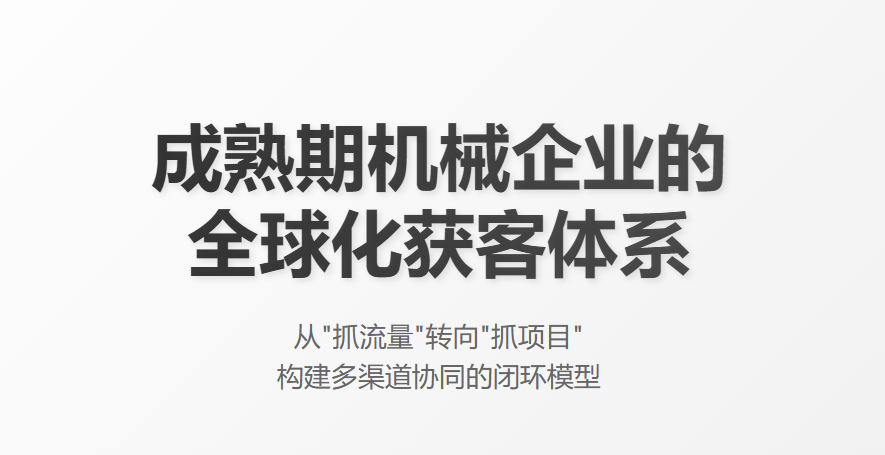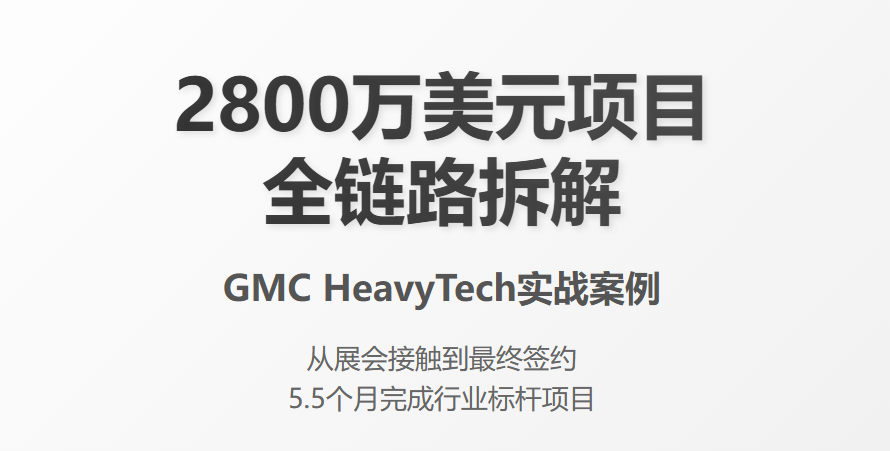
When a machinery company moves beyond the "survival-growth" stage and enters the mature stage , its customer acquisition logic undergoes a decisive change: from "capturing traffic" to "capturing projects"; from "grabbing inquiries" to "grabbing budgets"; from "finding customers" to "letting customers find you." Related reading: Machinery Industry Growth Stage Companies: The Most Profitable Channel Combination (Exhibitions + Platforms + Search + Email)
This article uses a mature machinery group with annual revenue of $800 million (pseudonym: GMC HeavyTech) as a real case study to deeply analyze how it continuously wins multi-million dollar projects through its global customer acquisition system.
The article focuses on the typical channel structures of mature companies:
Exhibitions/Industry Summits: 30%–40%
SEO + Brand Search: 20%–25%
Overseas agents/branches: 20%–25%
Social media/video platforms: 5%–10%
B2B platform: 5%–10%
Email/CRM Automation: 5%–15%
Advertising spending: 5%

After entering its mature stage, GMC views "global customer acquisition" as a continuous cycle:
Exposure → Interest → Technical Assessment → Solution Comparison → Tender Document → Negotiation → Implementation
The entire closed loop is driven by six types of channels:
1) Trade shows and summits are responsible for "building trust and getting major clients to see you".
2) Brand SEO is responsible for "making customers find you and recognize you".
3) The agent/branch office is responsible for "local trust + project implementation".
4) The case study library is responsible for "shortening the project evaluation and technology selection cycle".
5) The CRM system is responsible for "cultivating demand and capturing procurement windows".
6) Advertising/video/social media responsible for "strengthening brand recall"
Ultimately, this will lead to a mature customer acquisition system that is multi-channel collaborative and fully online .
The following section uses GMC's large order (US$28 million) for a port automation conveyor system in Southeast Asia as an example to break down its entire operation.

GMC had a large 180m² booth at the Asian Logistics Summit in Manila.
Key actions:
The core product module (detachable demo) was on display.
The Chief Technology Officer gave a presentation ("The Latest Trends in Port Automation").
The booth features a demonstration screen showcasing a cargo port simulation system.
Client A (one of the largest logistics groups in Southeast Asia) first came into contact with GMC here.
Post-exhibition actions:
Scan the code on-site → Automatically access CRM ( AB Customer CRM, all features free to use )
The "Port Automation Solution Package PDF" will be automatically sent within 2 hours.
The regional manager will conduct the first follow-up visit within 3 days.
Experience from mature companies: Trade shows are not about running around to trade shows, but about gathering project leads.
After the client team returned, they searched on Google:
"Port transport system supplier"
“bulk material handling automation”
"GMC HeavyTech + solution"
GMC's brand name and generic terms both rank in the top 3 on the homepage .
The core pages that customers click on include:
Industry Solutions Page (Automation for Ports)
Large Project Case Library
Video demo page
The information provided on these pages directly influences whether a customer proceeds to the next round:
3 Port Project Case Studies
Technical principles + drawing download
ROI Calculation Template (Excel)
This is why established businesses must do brand SEO: when clients are in the "solution comparison" stage, search results determine whether to continue the conversation.
(Note: GMC's official website uses an AB customer enterprise-level website building architecture with multiple languages and product categories , which is very friendly to large groups.)
GMC's distributor in Malaysia is responsible for:
Visit to the Port Authority
Coordinating Technical Exchange Meeting
Assist in preparing tender documents
Follow up on local compliance requirements (Customs/Port Authority security standards).
Why are distributors a "must-have for mature companies"?
Familiar with policies
Able to access key personnel
Building local trust
Able to provide after-sales delivery
Project progresses faster
For large orders from established companies, 80% of them require an agency system.
At this stage, the customer's primary concern is:
reliability
Do you have experience with similar projects?
Lifetime Cost
After-sales service capability
Security Certification
GMC directly draws upon its "global large-scale project case library" .
The content includes:
Implementation Timeline
Customer Challenges
Solution Drawings
Project ROI
Debugging process
The entire video recording (from installation to operation)
Through our case library, we help clients do three things:
1) Report to the internal board of directors (reduce communication costs)
2) Reduce concerns about "trial and error costs"
3) Demonstrate the supplier's capabilities (not boasting, but verifiable).
The core competitiveness of a mature machinery group lies in its experience in undertaking large-scale projects, and its case library serves as the strongest endorsement of its credibility.
Through a combination of online and offline meetings:
The technical team explained the system design.
The project team provides a timeline.
The finance team provides the TCO (Total Cost of Ownership).
The agent is responsible for local coordination.
After the meeting, the client proceeded to the "budget approval stage".
The GMC CRM system triggers processes through automation:
Project update reminder
Comparison Table of Schemes
Risk assessment document
After-sales SLA Draft
This enables large clients to quickly achieve compliance.
The reasons why the client ultimately chose GMC:
The exhibition has high credibility.
SEO allows clients to have a second confirmation of our "technical capabilities".
Agents accelerate project progress
Case study library reduces internal resistance
The solution is mature and has low risk.
Strong project management skills
The entire project took 5.5 months from lead to contract signing (the industry average is 8–12 months).

Mature companies are not afraid to spend money:
Large booth
High-quality prototype
Technical presentation
VIP Private Session
Because one large project can be equivalent to the cost of 10 exhibitions .
Mature companies don't rely on luck to get inquiries; they rely on:
Technical keyword ranking
Brand keyword placeholder
Industry Solution Articles
Video page
Drawing download page
For mature companies, SEO is not about writing articles, but about writing an "engineering manual".
The value of an agent:
Familiar with policies
Familiar network
Negotiation
Capable of delivery
Zero language barrier
Can do after-sales service
Large projects are almost inseparable from an agency system.
A mature company's case study library must include:
Video
drawing
Data-driven (ROI/TCO)
Failure Rate Display
Full process record
The more realistic and "engineering-like" the case studies are, the easier it is for major clients to sign off.
Key actions:
Tender submission reminder
Automatic data push during project phases
Approval progress record
Multi-departmental collaboration
Automatically follow up to the decision-maker
This is the biggest difference between mature enterprises and small and medium-sized enterprises.
Mature companies have stable channel structures:
Exhibitions: A Starting Point for Major Projects
SEO: Stability Brings Passive Leads
Agent: Increase conversion rate
Social Media/Video: Brand Memory
B2B: Replenishing the Lead Pool
Advertisement: Short-term traffic
CRM: Reduce Churn
It's not a single point, but a system.
Set up industry-themed exhibition areas
CEO/CTO Speech
Follow-up must be completed within 72 hours after the exhibition.
Establish a dedicated CRM process for trade show leads
Establish a multilingual, multi-category structure (refer to AB Customer's enterprise-level website building ).
Deep Solutions Page
Real Project Case Library
Industry White Paper
Technical articles (not blog posts, but articles on technical standards)
Optimize agent incentive policies
Provide sales toolkits (PPT/case studies/ROI tools) for agents.
Regular technical training
Clue rating
Phase Reminder
Automated email dripping
Online Document Center
Video-based: Project videos, factory capabilities, testing
Drawing representation: schematic diagram/flowchart
Data-driven: ROI, energy consumption, project duration, maintenance costs
The case of GMC HeavyTech illustrates this point:
Large projects are never completed in a single transaction, but are the result of a system-wide effort.
Trade shows open doors, SEO builds trust, agents accelerate projects, case studies facilitate procurement, and CRM prevents lost orders.
This is the underlying logic behind the mature machinery group's continued success in securing multi-million dollar projects.
.png?x-oss-process=image/resize,h_100,m_lfit/format,webp)
.png?x-oss-process=image/resize,h_100,m_lfit/format,webp)

.png?x-oss-process=image/resize,h_100,m_lfit/format,webp)
.png?x-oss-process=image/resize,h_100,m_lfit/format,webp)
.png?x-oss-process=image/resize,h_100,m_lfit/format,webp)
.png?x-oss-process=image/resize,h_100,m_lfit/format,webp)
